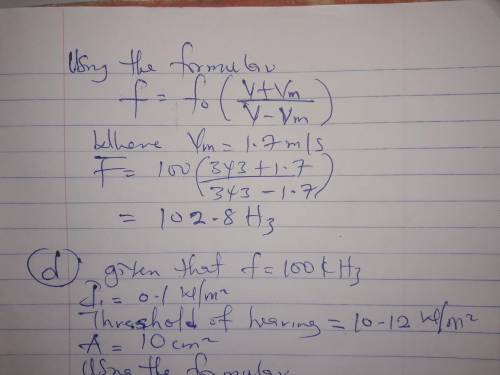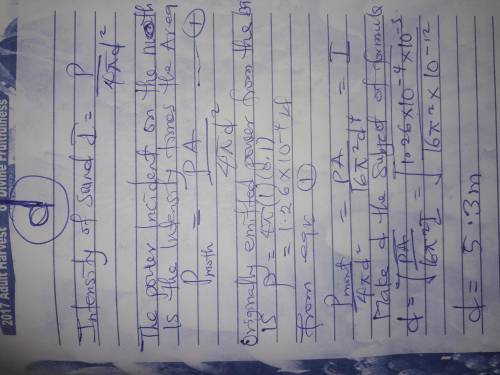
Physics, 06.05.2020 03:21 Drellibus70011
Bats are not blind, but they can hunt in complete darkness, using ultrasonic sound waves to detect both the position and
the motion of their prey. ("Ultrasonic" means at a higher frequency than humans can hear. "Supersonic" means faster than the speed of sound.) High-intensity, high-frequency sound pulses are emitted from their snouts, and they hear echoes from sound waves reflected from the prey. This process is known as echolocation.
a) Suppose the friendly and graceful bat pictured above tries to locate a moth by emitting sound pulses and detecting the echo. The bat sounds are emitted at f0 = 100.0 kHz. If the echo returns a time t = 0.25 s after the bat emits the sound, how far away is the moth?
b) The frequency of the returning echo pulse is 101.0 kHz. What is the speed vm of the moth? Is it moving toward or away from the bat? Note: the echo from the moth is essentially a sound absorption (in which the moth acts as a moving observer) plus an immediate re-emission (in which the moth then acts as a moving source of sound at the same frequency that it just observed).
c) Now the bat itself begins to move toward the moth at a speed of vb = 3 m/s. What is the frequency of the sound pulses as heard by the moth? What is the frequency of the echo pulses received by the bat?
d) Bats require extremely sensitive hearing to detect small prey using echolocation. Suppose the bat emits a 100.0-kHz sound whose intensity is measured 1 cm from the bat’s mouth to be 0.1 W/m2. If the bat’s threshold of hearing is 10–12 W/m2 at this frequency, what is the maximum distance from the bat at which it could detect a moth of area 10 cm2? You can assume that the bat emits sound isotropically (i. e., uniformly in all directions) with power P, that 100% of the intensity is reflected, and that the reflected sound is emitted isotropically from the moth.

Answers: 3
Another question on Physics

Physics, 22.06.2019 11:00
1.)the isotope cobalt-60 has a nuclear mass of 59.933820 u calculate the mass defect of cobalt-60 using the following information. mass of proton: 1.007825 u mass of neutron: 1.008665 u 1 u = 931.5 mev 2.)the isotope cobalt-60 has a nuclear mass of 59.933820 u calculate the binding energy of cobalt-60 using the following information. mass of proton: 1.007825 u mass of neutron: 1.008665 u 1 u = 931.5 mev 3.)the isotope cobalt-60 has a nuclear mass of 59.933820 u calculate the binding energy per nucleon of cobalt-60 using the following information. mass of proton: 1.007825 u mass of neutron: 1.008665 u 1 u = 931.5 mev
Answers: 3

Physics, 22.06.2019 19:30
A47.2 g block of copper whose temperature is 480 k is placed in an insulating box with a 91.8 g block of lead whose temperature is 200 k. (a) what is the equilibrium temperature of the two-block system? (b) what is the change in the internal energy of the two-block system between the initial state and the equilibrium state? (c) what is the change in the entropy of the two-block system? the heat capacities of copper and lead are 386 j/kg·k and 128 j/kg·k, respectively.
Answers: 1

Physics, 22.06.2019 22:30
Compare the patterns of the two waves shown in the image. which statement is true about these waves?
Answers: 1

Physics, 23.06.2019 00:00
Abus travels 280km south along a straight path with an average velocity of 88km/h to the south. the bus stops for 24 min, then it travels 210 km south with an average velocity of 75 km/h to the south. how long does the total trip last?
Answers: 1
You know the right answer?
Bats are not blind, but they can hunt in complete darkness, using ultrasonic sound waves to detect b...
Questions


History, 16.09.2019 06:30

Mathematics, 16.09.2019 06:30

Computers and Technology, 16.09.2019 06:30



History, 16.09.2019 06:30




Mathematics, 16.09.2019 06:30



History, 16.09.2019 06:30



Mathematics, 16.09.2019 06:30


Mathematics, 16.09.2019 06:30

English, 16.09.2019 06:30






